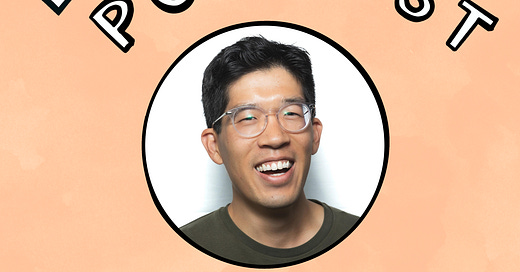Brought to you by:
• BuildBetter—AI for product teams
• OneSchema—Import CSV data 10x faster
• Eppo—Run reliable, impactful experiments
—
Kevin Yien leads product for merchant experiences at Stripe. Before that, he meandered his way from being a technical designer to a product manager, built the restaurants business and ecosystem team at Square, and most recently was head of product and design at Mutiny. He also makes ice cream and teaches for fun. In our conversation, we discuss:
Why aspiring PMs should start in engineering, design, or sales
The importance of writing skills, and how to become a better writer
How to automate user research
Kevin’s “unsell email” technique for hiring
The value of keeping a decision log
Insights on AI and its impact on future generations
Lessons from failure
Listen now on Apple, Spotify, and YouTube.
Some takeaways:
Great PMs need to be great writers. Writing is “clarity at scale,” and a key component of a PM’s job is creating clarity both internally and externally. Improve your writing by doing the following:
Read widely and critically: Read a variety of sources, including essays, articles, and books, focusing on those that demonstrate compelling and clear writing.
Emphasize clarity: Ensure that your product requirements documents (PRDs) and other communications are crisp, clear, and articulate. Avoid jargon and be specific about objectives, tasks, and outcomes.
Tailor your writing style to the audience you’re addressing: Whether it’s technical details for developers or strategic vision for executives, adjust your tone and language accordingly to ensure effective communication.
Experiment with cadence: Incorporate varied sentence structures to maintain reader engagement. Avoid monotonous writing patterns by mixing short and long sentences, and use rhythmic variations to keep the reader interested.
Practice regularly: Write daily or weekly to refine your style and voice. Consider starting a blog, journaling, or drafting product-related content to enhance your writing capabilities.
Keep a decision log to improve your product sense. You can do so in a Google Doc, Notion page, or a simple notebook. Each entry should include the date, the decision made, the rationale behind it, and any expected outcomes. For example, if you decide to implement a new feature, note why you made that choice and what you anticipate will happen. Set a calendar reminder every three to six months to revisit and evaluate the outcomes of your past decisions. Reflect on what worked, what didn’t, and why.
Before you present an offer to a hiring candidate, send them an “unsell email” that lists all the reasons why they may not want to work at your company. Providing a clear view of the role, warts and all, at the end of the hiring process helps candidates better understand the job and address any of their concerns that may have risen along the way. Don’t be discouraged if candidates decline your offer—you’ll save time and money down the line by preventing early employee turnover.
Automate user research to save time and gain direct insights. Some specific tactics Kevin recommends:
Implement tools like User Interviews to streamline the process of recruiting participants. Set clear criteria for your ideal customer profile (ICP), and let the platform handle the sourcing. This will ensure a steady stream of qualified participants without the manual effort of searching and contacting them.
Integrate Gong with your Slack workspace to automatically receive alerts about specific terms or issues mentioned in sales calls. Set up filters and alerts for relevant keywords and phrases, and use Zapier to automate the scheduling of interviews based on these alerts. For example, if a term like “POS system” is mentioned, a Slack alert can trigger an automated workflow that sends an email to the customer, including your Calendly link to schedule a research interview.
When facing setbacks like layoffs, separate your self-worth from your job performance. Use these moments to reflect on two key points:
Business fit: Recognize that sometimes a company’s current needs don’t align with your skills, but this doesn’t reflect your capability. Consider if the role was a mismatch with the company’s environment or needs rather than a failure on your part.
Skill fit: Understand that your skills may be strong, but not suited to every company’s way of working. Seek environments that align better with your strengths and working style. This reassessment can lead you to opportunities where you can thrive and demonstrate your full potential.
Where to find Kevin Yien:
• LinkedIn: https://www.linkedin.com/in/kevinyien/
• Website: https://kevinyien.com/
In this episode, we cover:
(00:00) Kevin’s background
(02:00) The story behind Kevin’s profile picture
(08:41) The role of a product manager
(10:48) Getting started in product management
(12:47) The importance of writing skills
(15:06) Becoming a better writer
(19:10) The PM’s role with engineering and design
(28:41) Drawing the perimeter for your team
(31:37) Feedback tips
(35:13) Decision logs and product sense
(45:36) Unorthodox hiring strategies
(47:01) The unsell email strategy
(54:01) Automating user research
(01:02:27) AI in everyday life
(01:06:05) Lessons from failure
(01:14:34) Lightning round
Referenced:
• Chris Dixon’s website: https://cdixon.org/
• Stripe: https://stripe.com/
• Twilio: https://pages.twilio.com/
• Figma: https://www.figma.com/
• Paul Graham’s website: https://www.paulgraham.com/
• Joan Didion quote: https://www.goodreads.com/quotes/264509-i-don-t-know-what-i-think-until-i-write-it
• Anthony Bourdain: https://en.wikipedia.org/wiki/Anthony_Bourdain
• Write Simply: https://paulgraham.com/simply.html
• How to Write Usefully: https://paulgraham.com/useful.html
• Write Like You Talk: https://paulgraham.com/talk.html
• Several Short Sentences About Writing: https://www.amazon.com/Several-Short-Sentences-About-Writing/dp/0307279413
• Bruce Bell on LinkedIn: https://www.linkedin.com/in/brucebell/
• Square: https://squareup.com/
• Building product at Stripe: craft, metrics, and customer obsession | Jeff Weinstein (Product lead): https://www.lennysnewsletter.com/p/building-product-at-stripe-jeff-weinstein
• Jaleh Rezaei on LinkedIn: https://www.linkedin.com/in/jalehr/
• Mutiny: https://www.mutinyhq.com/
• Shreyas Doshi on pre-mortems, the LNO framework, the three levels of product work, why most execution problems are strategy problems, and ROI vs. opportunity cost thinking: https://www.lennysnewsletter.com/p/episode-3-shreyas-doshi
• LNO framework: https://x.com/shreyas/status/1492345184171945984
• Bending the universe in your favor | Claire Vo (LaunchDarkly, Color, Optimizely, ChatPRD): https://www.lennysnewsletter.com/p/bending-the-universe-in-your-favor
• Shopify: https://www.shopify.com/
• Life Inside One Big Text File: https://www.43folders.com/2005/08/17/life-inside-one-big-text-file
• The Unsell Email: https://kevinyien.com/blog/unsell.html
• Zappy: https://zapier.com/zappy
• Bethany Hills on LinkedIn: https://www.linkedin.com/in/bethany-hills/
• Teresa Torres on how to interview customers, automating continuous discovery, the opportunity solution tree framework, making the case for user research, common interviewing mistakes, and much more: https://www.lennysnewsletter.com/p/teresa-torres-on-how-to-interview
• Patrick Collison’s website: https://patrickcollison.com/
• Midjourney: https://www.midjourney.com/home
• The Courage to Be Disliked: The Japanese Phenomenon That Shows You How to Change Your Life and Achieve Real Happiness: https://www.amazon.com/Courage-Be-Disliked-Phenomenon-Happiness/dp/1668065967
• What to Know About Adlerian Theory: https://www.verywellmind.com/alderian-theory-definition-techniques-and-efficacy-5213796
• Jungian psychology: https://www.routledge.com/blog/article/what-is-jungian-psychology
• The Paper Menagerie and Other Stories: https://www.amazon.com/Paper-Menagerie-Other-Stories/dp/148142436X
• Sean Rose on X: https://x.com/seanrose
• The Bear on Hulu: https://www.hulu.com/series/the-bear-05eb6a8e-90ed-4947-8c0b-e6536cbddd5f
• Physical: 100 on Netflix: https://www.netflix.com/title/81587446
• Magnetic trays: https://www.amazon.com/VASTOOLS-Magnetic-Holder-Stainless-Socket/dp/B07MSH6K86
• Circuit app: https://mahanti.co/circuit/
• Joey Chestnut’s website: https://www.joeychestnut.com/
• Manny’s Steakhouse: https://mannyssteakhouse.com/
Production and marketing by https://penname.co/. For inquiries about sponsoring the podcast, email podcast@lennyrachitsky.com.
Lenny may be an investor in the companies discussed.















Share this post